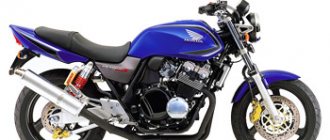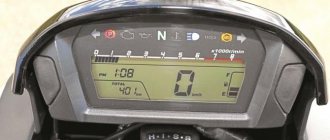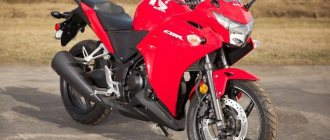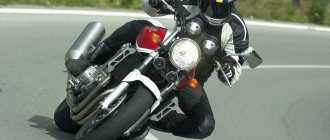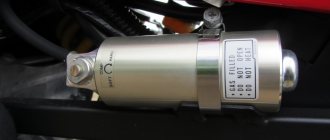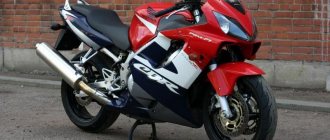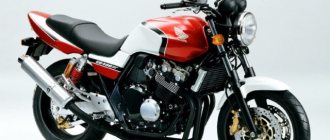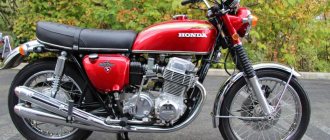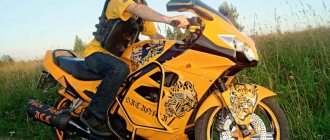- Honda motorcycle model
The Honda CBR600F sports motorcycle model begins its history with the 1987 Honda CBR600F Hurricane model. The model featured a steel frame, narrow wheels and a maximum power of 87 hp.
In 1991, the motorcycle was updated to the next generation - Honda CBR600F2. In addition to the updated appearance, the model receives a new engine (maximum power increased to 100 hp), new wheels, suspension and carburetors.
In 1995, a new generation appeared - the Honda CBR600F3. It gets a more modern appearance, new suspensions, larger front brake discs, and an increased engine compression ratio.
In 1999, the next generation of the model was the Honda CBR600F4. The model receives many changes - a new appearance, an aluminum frame, new adjustable suspension, a wider rear wheel, a new brake system with 4-piston front calipers, a new engine (maximum power 110 hp), new carburetors.
In 2001, the model underwent its final restyling, releasing the most popular model in the series - the Honda CBR600F4i. The main difference from the previous version was the use of an injector (PGM-Fi). Other changes affected overall dimensions, weight (1 kg lighter), increased fuel tank capacity (from 17 to 18 liters), gearbox ratios and generator power (increased from 343 to 433 W).
2006 was the last year of production of the Honda CBR600F4i model, after which it finally left the market. In 2011, Honda decided to resurrect the series by building a new generation - the Honda CBR600F. This model was built on the basis of the latest generation Honda CB600F Hornet and is very different from the previous generation CBR600F.
In 2013, the Honda CBR600F was discontinued, giving way to a new model - the Honda CBR650F
For whom
Here are the main features of the model:
- distinctive sporty design;
- comfortable ride that does not strain your back;
- good performance in terms of power and torque.
This model, strictly speaking, is not quite a sports bike, unlike previous versions. However, such a machine is in no way suitable for a beginner, because only a professional can handle it.
Dimensions and weight
The dry weight of the car is 170 kg, while the fuel tank volume is 18 liters. Taking into account the average consumption of 6 liters per hundred, the gas tank capacity should be absolutely sufficient. In terms of dimensions, the car occupies an average position in the class.
Specifications
| Model | Honda CBR600F |
| Motorcycle type | sports |
| Year of issue | 1987-2013 |
| Frame | Double pipe (steel) - CBR600F1-F3 Double Tube, Box Type (Aluminum) - CBR600F4, F4i Aluminum cast - CBR600F (2011-2013) |
| engine's type | 4-cylinder, 4-stroke, in-line |
| Working volume | 598 cm³ |
| Bore/Stroke | 63.0 x 48.0 mm – CBR600F Hurricane 65.0 x 45.2 mm – CBR600F2, F3 67.0 x 42.5 mm – CBR600F4, F4i, CBR600F (2011-2013) |
| Compression ratio | 11.0:1 – CBR600F Hurricane 11.6:1 – CBR600F2 12.0:1 – CBR600F3, F4, F4i, CBR600F (2011-2013) |
| Cooling | liquid |
| Number of valves per cylinder | DOHC, 4 valves per cylinder |
| Fuel supply system | Carburetor, 4x 32mm – CBR600F Hurricane Carburetor, 4x 34 mm – F2 Carburetor, 4x 36 mm – F3 Carburetor, 4x 36.5 mm – F4 Injector (PGM-Fi), 4x 38mm – F4i, CBR600F (2011-2013) |
| Ignition type | digital transistor |
| Maximum power | 87.0 hp (64.0 kW) at 11000 rpm – CBR600F Hurricane 100.0 hp (73.5 kW) at 12000 rpm – CBR600F2, F3 110.0 hp (81.0 kW) at 12500 rpm – CBR600F4, F4i 102.0 hp (75.0 kW) at 12000 rpm – CBR600F (2011-2013) |
| Maximum torque | 60 Nm (6.1 kg*m) at 8500 rpm – CBR600F Hurricane 64 Nm (6.5 kg*m) at 10500 rpm – CBR600F2, F3 62 Nm (6.3 kg*m) at 10,000 rpm – CBR600F4, F4i 65 Nm (6.6 kg*m) at 10500 rpm – CBR600F (2011-2013) |
| Transmission | 6-speed |
| type of drive | chain |
| Front tire size | 110/80-V17 – CBR600F Hurricane 120/60-ZR17 – CBR600F2, F3 120/70-ZR17 – F4, F4i, CBR600F (2011-2013) |
| Rear tire size | 130/80-V17 – CBR600F Hurricane 160/60 ZR 17 – CBR600F2, F3 180/55 ZR 17 – CBR600F4, F4i, CBR600F (2011-2013) |
| Front brakes | 2 discs, 276 mm, 2-piston calipers – CBR600F Hurricane, F2 2 discs, 296 mm, 2-piston calipers – CBR600F3 2 discs, 296 mm, 4-piston calipers – CBR600F4, F4i 2 discs, 296 mm, 2-piston calipers (optional - ABS) – CBR600F (2011-2013) |
| Rear brakes | 1 disc, 220 mm, 1-piston caliper – CBR600F Hurricane, F2, F3, F4, F4i 1 disc, 240 mm, 1-piston caliper (optional - ABS) – CBR600F (2011-2013)) |
| Front suspension | 37mm telescopic fork, 130mm travel – CBR600F Hurricane 41mm telescopic fork – CBR600F2 41 mm telescopic fork HMAS (adjustable preload and rebound), travel - 118 mm - CBR600F3 43mm HMAS telescopic fork (fully adjustable), 120mm travel – CBR600F4, F4i 41 mm inverted fork (adjustable preload and rebound) - CBR600F (2011-2013) |
| Rear suspension | Pendulum with monoshock absorber (adjustable preload), stroke - 110 mm - CBR600F Hurricane Pendulum with monoshock absorber (adjustable preload and rebound) – CBR600F2 Pendulum with HMAS monoshock absorber (fully adjustable), stroke - 120 mm - CBR600F3, F4, F4i Pendulum with monoshock absorber (adjustable preload) - CBR600F (2011-2013) |
| Motorcycle length | 2130 mm – CBR600F Hurricane 2020 mm – CBR600F2 2055 mm – CBR600F3 2060 mm – CBR600F4 2041 mm – CBR600F4i 2150 mm – CBR600F (2011-2013) |
| Motorcycle width | 685 mm |
| Motorcycle height | 1115 mm – CBR600F Hurricane 1130 mm – CBR600F2, F4 1135 mm – CBR600F3, F4i 1150 mm – CBR600F (2011-2013) |
| Wheelbase | 1410 mm – CBR600F Hurricane 1405 mm – CBR600F2, F3 1390 mm – CBR600F4 1386 mm – CBR600F4i 1435 mm – CBR600F (2011-2013) |
| Seat height | 770 mm – CBR600F Hurricane 810 mm – CBR600F2, F3, F4, F4i 800 mm – CBR600F (2011-2013) |
| Minimum ground clearance (clearance) | 140 mm – CBR600F Hurricane, F2 130 mm – CBR600F3 135 mm – CBR600F4, F4i, CBR600F (2011-2013) |
| Acceleration to 100 km/h | 3.0-3.5 sec |
| Maximum speed | 210 km/h – CBR600F Hurricane, F2 250 km/h – CBR600F3, F4, F4i 220 km/h - CBR600F (2011-2013) |
| Gas tank capacity | 16.5 l – CBR600F Hurricane 16.0 l – CBR600F2 17.0 l – CBR600F3, F4 18.0 l – CBR600F4i 18.4 l – CBR600F (2011-2013) |
| Motorcycle weight (dry) | 182 kg – CBR600F Hurricane 186 kg – CBR600F2 184 kg – CBR600F3 169 kg – CBR600F4 168 kg – CBR600F4i |
| Motorcycle weight (curb) | 201 kg – CBR600F Hurricane 205 kg – CBR600F2 206 kg – CBR600F3, CBR600F (2011-2013) 197 kg – CBR600F4 196 kg – CBR600F4i 211 kg – CBR600F ABS (2011-2013) |
Chassis and brakes
The frame here is made of steel. Of course, such a motorcycle can only have cast wheels. The steering wheel is typical for the class. The entire exterior looks elegant and sporty, and in some places even futuristic, thanks to its streamlined shapes.
The suspension at the rear is a pendulum version with a monoshock absorber, while at the front there is an inverted fork measuring 41 mm. The rear brake features a 240 mm disc along with a single-piston caliper, while at the front there is a 296 mm dual disc with two-piston calipers.
We all know the formidable representative of the Supersports class - the Honda CBR 600 RR, but before the light of day saw the light of the model line of motorcycles with the letter “RR”, the company had come a long way in the world of motorsports and forever etched itself in history, so today we will talk about the great sportbikes of the past and one of the biggest misconceptions of the modern motorcycle community. Those of you who did not follow the world history of motorcycle racing before 2000 may not be able to imagine that at one time, just looking at the Honda CBR 600, fear was instilled in riders of other brands, and this fear was not far-fetched . During the years 1987-1998, it was almost an anomaly to see anything other than the Honda CBR600F in the winners' circle, all the magazines were simply full of Honda's superiority in the 600cc class, but about everything in order...
1987-1990 Honda CBR600 Hurricane
In 1987, Honda released its first production 4-cylinder sports bike with an all-plastic body kit, the CBR600F, originally known as the Hurricane. The Honda CBR600F had a 16-valve engine producing 85 hp. at 11,000 rpm and a 6-speed gearbox. The Hurricane loudly announced its intentions to take the CBR line to the top of the technological Olympus, becoming the first sports bike to cover 402 meters (a quarter mile) in 11 seconds. It was the fastest motorcycle in the 600cc class, and Honda, having set a high bar for competitors, retained this title for a long time and only in 1995 the new Ninja ZX-6R was able to break this record. Honda engineers were able to achieve a unique combination of power and weight of a motorcycle that was almost 14 kg lighter than the 2-year-old Ninja 600 - about the same as the GSX-R 750, but without the use of exotic materials and an aluminum frame. The CBR's top speed was around 229 km/h. What's not the ideal cocktail for future victories? And so it happened - Honda in 1987 won all 9 rounds of the AMA 600 cc SuperSport racing series, surpassing rivals from other teams head and shoulders.
This first CBR600 turned out to be a truly revolutionary machine, which in the year of its debut was elevated to a generally recognized class standard and forced the whole world to follow the development of the line, collecting impressive reviews in magazines.
1991-1994 Honda CBR600F2
In 1991, the second model of the now famous sportbike was born. How good is the CBR600F2? I'll tell you that more than most can imagine! In amateur competitions, riders still win prizes in them to this day. It’s no wonder that this motorcycle was the best-selling sportbike in America throughout its entire life cycle. What is the reason for the even greater success of this model compared to its parent? F2 received the following changes: Increased compression ratio from 11.3:1 to 11.6:1. The old rocker mechanism that operated the valves was replaced with the more familiar puck-type pushrod method. This made it possible to increase the gap between the necessary valve adjustments from 8,000 to 19,000 km. The fork has grown in diameter from 37 mm to 41 mm and has acquired the ability to adjust the preload. At the same time, the motorcycle received a new Showa rear shock absorber with the ability to adjust compression and rebound. The frame geometry has been significantly revised, but it remains made of steel, and the bike weighs just 206 kg, effectively making it the lightest bike in its class. For comparison, the Kawasaki ZX-6 weighed 222 kg, and the Yamaha FZR600 208 kg. Honda claims that the engine power of the “six hundred” has been increased to the coveted 100 hp mark. With. (at 12,500 rpm) and the motorcycle can now accelerate to 236 km/h, and the time to overcome the 100 km/h mark will be only 3.5 seconds.
And when it comes to victories on the race track, Honda dominates again! In 1991, Miguel Duhamel won seven of the nine races in the AMA 600cc Supersport Championship in the new Honda CBR F2. There was even a joke among motorcyclists of that time: “If you want to win a race, you need to ride a Honda.”
1995-1998 Honda CBR600F3
In 1995, Honda decided it was time to redesign its sportbike. This is how the CBR600F3 was born. Although Honda dominated the 600cc class at the time both on the track and in retail sales, the company knew that without a complete refresh their reign would soon come to an end. Although F3 is very similar to F2, many improvements have been made. The F3 received new carburetors and an inertial air induction system, which helped remove another five horsepower from the old F2. The compression ratio was increased to 12.0:1, which required a slight modification to the ignition system. All the engine changes raised the rev limit to 13,300 rpm and increased peak power to just over 100 hp. at 12,000 rpm. The updated CBR has improved brakes by increasing the diameter of the brake discs to 296mm. In addition, the F3 engine was revised twice during its life. The main changes affected the engine head, that is, in the 1998 model year the motorcycle has slightly more power than the 97, and it, in turn, exceeds the performance of 95-96, but the difference between them is less than 10 hp, and officially peak power this model was 105 hp. The electronic ignition and ram-air systems were also slightly tweaked for 1998 to smooth out throttle response that was sometimes jerky. There were also a number of minor changes within the same model, such as the installation of a deeper oil pan on 1997-1998, giving a more streamlined tail, seat and taillight.
With such an arsenal, CBR could not lose face at the races. The 1995 AMA 600cc Supersport season was still a successful one for Honda, with driver Miguel Duhamel finishing on top of the podium for eight races in a row. Honda F3 has won 11 races this year, leaving an undeniable lead.
Summary
The Honda CBR600 is a legendary sportbike with extensive racing experience, thanks to which it became a three-time World Champion in the supersport class! Was the motorcycle reliable? Any CBR600F from the entire line could, subject to regular maintenance, travel more than 160,000 km. Dan Kyle raced F2 and F3 in the AMA 600cc Supersport for several years and he spoke very highly of the bike's reliability. This is also evidenced by one of his stories: “In 1996, we tested the new F3 engine on the track. After a few laps, we noticed that the bike began to smoke, after which the engine died. After inspection, we realized that the entire cooling system was dry. This happened on the track at race pace, but the engine did not give up for several laps. I later opened the engine, assuming it was dead, but the cylinders had slightly visible piston contact marks from excessive overheating. After tinkering with the engine just a little bit, we did a power test on the dyno and it performed better than any other F3 we've built!” The CBR600Fs were very reliable and had only a few minor issues. It was the hydraulic timing chain tensioner and charging relay that failed before the service life allotted by the manufacturer. Otherwise, the motorcycles had no serious shortcomings, and even now we can easily find quite live specimens on the additional stages. Many owners note that the motorcycle was very balanced, it was possible to easily move around the city or race far along the highway, and on the weekends show a good level on the track. Modern motorcycles are characterized by an extremely narrow specialization and their owners often find it difficult to imagine that one motorcycle can do all this, and the majority do not use them at all. And so, today you will have to remember once and for all that the CBR600F in its past was never a sports tourer, it is a racing machine that has practically not left the pedestal for 10 years, setting a new pace for technological development of the entire motorcycle industry.
"If you want to win a race you need to ride a Honda"
1995 Australian 600cc Supersport Championship
